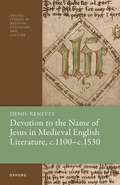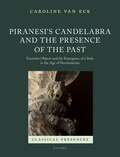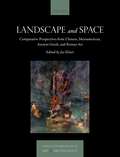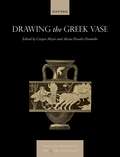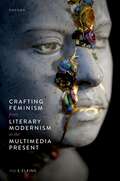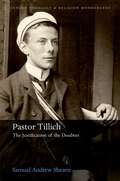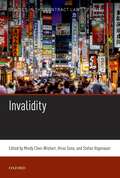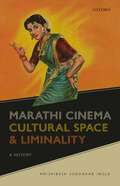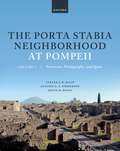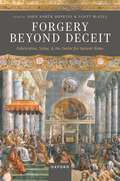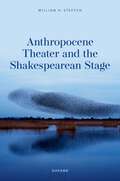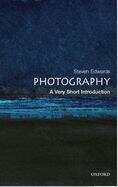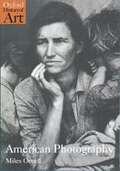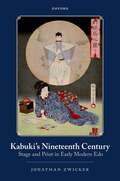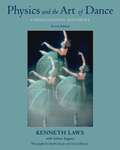- Table View
- List View
Devotion to the Name of Jesus in Medieval English Literature, c. 1100 - c. 1530 (Oxford Studies in Medieval Literature and Culture)
by Denis ReneveyDevotion to the Name of Jesus in Medieval English Literature, c. 1100 - c. 1530 offers a broad but detailed study of the practice of devotion to the Name of Jesus in late medieval England. It focuses on key texts written in Latin, Anglo-Norman, and Middle English that demonstrate the way in which devotion moved from monastic circles to a lay public in the late medieval period. It argues that devotion to the Name is a core element of Richard Rolle's contemplative practice, although devotion to the Name circulated in trilingual England at an earlier stage. The volume investigates to what extent the 1274 Second Lyon Council had an impact in the spread of the devotion in England, and beyond. It also offers illuminating evidence about how Margery Kempe and her scribes used devotion, how Eleanor Hull made it an essential component of her meditative sequence seven days of the week, and how Lady Margaret Beaufort worked towards its instigation as an official feast.
Piranesi's Candelabra and the Presence of the Past: Excessive Objects and the Emergence of a Style in the Age of Neoclassicism (Classical Presences)
by Caroline van EckNear the end of his life, Giovanni Battista Piranesi (1720-78) created three colossal candelabra mainly from fragments of sculpture excavated near the Villa Hadriana in Tivoli, two of which are now in the Ashmolean Museum, and one in the Louvre. Although they were among the most sought-after and prestigious of his works, and fetched enormous prices during Piranesi's life, they suffered a steep decline in appreciation from the 1820s onwards, and even today they are among the least studied of his works. Piranesi's Candelabra and the Presence of the Past uncovers the intense investment, by artists, patrons, collectors, and the public around the start of the nineteenth century in objects that made Graeco-Roman Antiquity present again. Caroline van Eck's study examines how objects make their makers or viewers feel that they are again in the presence of Antiquity, that not only Antiquity has revived, but that classical statues become alive under their gaze. what it takes to make such objects, and what it costs to own them; and about the ramifications of such intense if not excessive attachments to artefacts. This book considers the three candelabra in depth, providing the biography of these objects, from the excavation of the Roman fragments to their entry into private and public collection. Van Eck considers the context that Piranesi gave them by including them in his Vasi, Candelabri e Cippi (1778), to rethink the processes that led to the development of neoclassicism from the perspective of the objects and objectscapes that came into being in Rome at the end of the eighteenth century.
Piranesi's Candelabra and the Presence of the Past: Excessive Objects and the Emergence of a Style in the Age of Neoclassicism (Classical Presences)
by Caroline van EckNear the end of his life, Giovanni Battista Piranesi (1720-78) created three colossal candelabra mainly from fragments of sculpture excavated near the Villa Hadriana in Tivoli, two of which are now in the Ashmolean Museum, and one in the Louvre. Although they were among the most sought-after and prestigious of his works, and fetched enormous prices during Piranesi's life, they suffered a steep decline in appreciation from the 1820s onwards, and even today they are among the least studied of his works. Piranesi's Candelabra and the Presence of the Past uncovers the intense investment, by artists, patrons, collectors, and the public around the start of the nineteenth century in objects that made Graeco-Roman Antiquity present again. Caroline van Eck's study examines how objects make their makers or viewers feel that they are again in the presence of Antiquity, that not only Antiquity has revived, but that classical statues become alive under their gaze. what it takes to make such objects, and what it costs to own them; and about the ramifications of such intense if not excessive attachments to artefacts. This book considers the three candelabra in depth, providing the biography of these objects, from the excavation of the Roman fragments to their entry into private and public collection. Van Eck considers the context that Piranesi gave them by including them in his Vasi, Candelabri e Cippi (1778), to rethink the processes that led to the development of neoclassicism from the perspective of the objects and objectscapes that came into being in Rome at the end of the eighteenth century.
Landscape and Space: Comparative Perspectives from Chinese, Mesoamerican, Ancient Greek, and Roman Art (Visual Conversations in Art and Archaeology Series)
Landscape has been a key theme in world archaeology and trans-cultural art history over the last half century, particularly in the study of painting in art history and in all questions of human intervention and the placement of monuments in the natural world within archaeology. However, the representation of landscape has been rather less addressed in the scholarship of the archaeologically-accessed visual cultures of the ancient world. The kinds of reliefs, objects, and paintings discussed here have a significant purchase on matters concerned with landscape and space in the visual sphere, but were discovered within archaeological contexts and by means of excavation. Through case studies focused on the invention of wilderness imagery in ancient China, the relation of monuments to landscape in ancient Greece, the place of landscape painting in Mesoamerican Maya art, and the construction of sacred landscape across Eurasia between Stonehenge and the Silk Road via Pompeii, this book emphasises the importance of thinking about models of landscape in ancient art, as well as the value of comparative approaches in underlining core aspects of the topic. Notably, it explores questions of space, both actual and conceptual, including how space is configured through form and representation.
Landscape and Space: Comparative Perspectives from Chinese, Mesoamerican, Ancient Greek, and Roman Art (Visual Conversations in Art and Archaeology Series)
by Jaś ElsnerLandscape has been a key theme in world archaeology and trans-cultural art history over the last half century, particularly in the study of painting in art history and in all questions of human intervention and the placement of monuments in the natural world within archaeology. However, the representation of landscape has been rather less addressed in the scholarship of the archaeologically-accessed visual cultures of the ancient world. The kinds of reliefs, objects, and paintings discussed here have a significant purchase on matters concerned with landscape and space in the visual sphere, but were discovered within archaeological contexts and by means of excavation. Through case studies focused on the invention of wilderness imagery in ancient China, the relation of monuments to landscape in ancient Greece, the place of landscape painting in Mesoamerican Maya art, and the construction of sacred landscape across Eurasia between Stonehenge and the Silk Road via Pompeii, this book emphasises the importance of thinking about models of landscape in ancient art, as well as the value of comparative approaches in underlining core aspects of the topic. Notably, it explores questions of space, both actual and conceptual, including how space is configured through form and representation.
Drawing the Greek Vase (Visual Conversations in Art and Archaeology Series)
How have two-dimensional images of ancient Greek vases shaped modern perceptions of these artefacts and of the classical past? This is the first scholarly volume devoted to the exploration of drawings, prints, and photographs of Greek vases in modernity. Case studies of the seventeenth to the twentieth century foreground ways that artists have depicted Greek vases in a range of styles and contexts within and beyond academia. Questions addressed include: how do these images translate three-dimensional ancient utilitarian objects with iconography central to the tradition of Western painting and decorative arts into two-dimensional graphic images carrying aesthetic and epistemic value? How does the embodied practice of drawing enable people to engage with Greek vases differently from museum viewers, and what insights does it offer on ancient producers and users? And how did the invention of photography impact the tradition of drawing Greek vases? The volume addresses art historians of the seventeenth to twentieth centuries, archaeologists and classical reception scholars.
Drawing the Greek Vase (Visual Conversations in Art and Archaeology Series)
by Caspar Meyer Alexia Petsalis-DiomidisHow have two-dimensional images of ancient Greek vases shaped modern perceptions of these artefacts and of the classical past? This is the first scholarly volume devoted to the exploration of drawings, prints, and photographs of Greek vases in modernity. Case studies of the seventeenth to the twentieth century foreground ways that artists have depicted Greek vases in a range of styles and contexts within and beyond academia. Questions addressed include: how do these images translate three-dimensional ancient utilitarian objects with iconography central to the tradition of Western painting and decorative arts into two-dimensional graphic images carrying aesthetic and epistemic value? How does the embodied practice of drawing enable people to engage with Greek vases differently from museum viewers, and what insights does it offer on ancient producers and users? And how did the invention of photography impact the tradition of drawing Greek vases? The volume addresses art historians of the seventeenth to twentieth centuries, archaeologists and classical reception scholars.
Crafting Feminism from Literary Modernism to the Multimedia Present
by Amy ElkinsCrafting Feminism develops a dynamic study of craft and art-making in modern and contemporary feminist writing. In evocative readings of literary works from Virginia Woolf to Zadie Smith, this book expands our sense of transartistic modernist scholarship to encompass process-oriented and medium-specific analyses of textile arts, digital design, collage, photography, painting, and sculpture in literary culture. By integrating these craft practices into the book's enlightening archive, Elkins's theoretical argument extends a reading of craft metaphors into the material present. Crafting Feminism demonstrates how writers have engaged with handiwork across generations and have undertaken the crafting of a new modernity, one that is queer and feminist-threaded, messy, shattered, cut-up, pasted together, preserved, repaired, reflected, and spun out. An avant-garde work of scholarship, this book interweaves queer research methods and interdisciplinary rigor with a series of surprising archival discoveries. Making visible the collaborative, creative features of craft, Elkins captivates readers with generous illustrations and a series of "Techne" interchapters-interludes between longer chapters, which powerfully convey the symbiosis between feminist theory and method, and detail the network of archival influences that underpin this volume's hybrid approach. Foregrounding the work of decentering patriarchal and Eurocentric legacies of artistic authority, Elkins champions the diverse, intergenerational history of craft as a way to reposition intersectional makers at the heart of literary culture. An original and compelling study, Crafting Feminism breaks new ground in modernist and visual studies, digital humanities, and feminist, queer, and critical race theory.
Crafting Feminism from Literary Modernism to the Multimedia Present
by Amy ElkinsCrafting Feminism develops a dynamic study of craft and art-making in modern and contemporary feminist writing. In evocative readings of literary works from Virginia Woolf to Zadie Smith, this book expands our sense of transartistic modernist scholarship to encompass process-oriented and medium-specific analyses of textile arts, digital design, collage, photography, painting, and sculpture in literary culture. By integrating these craft practices into the book's enlightening archive, Elkins's theoretical argument extends a reading of craft metaphors into the material present. Crafting Feminism demonstrates how writers have engaged with handiwork across generations and have undertaken the crafting of a new modernity, one that is queer and feminist-threaded, messy, shattered, cut-up, pasted together, preserved, repaired, reflected, and spun out. An avant-garde work of scholarship, this book interweaves queer research methods and interdisciplinary rigor with a series of surprising archival discoveries. Making visible the collaborative, creative features of craft, Elkins captivates readers with generous illustrations and a series of "Techne" interchapters-interludes between longer chapters, which powerfully convey the symbiosis between feminist theory and method, and detail the network of archival influences that underpin this volume's hybrid approach. Foregrounding the work of decentering patriarchal and Eurocentric legacies of artistic authority, Elkins champions the diverse, intergenerational history of craft as a way to reposition intersectional makers at the heart of literary culture. An original and compelling study, Crafting Feminism breaks new ground in modernist and visual studies, digital humanities, and feminist, queer, and critical race theory.
Pastor Tillich: The Justification of the Doubter (Oxford Theology and Religion Monographs)
by Samuel Andrew ShearnPastor Tillich: The Justification of the Doubter tells the story of Paul Tillich's early theological development from his student days until the end of the First World War, set against the backdrop of church politics in Wilhelmine Germany and with particular reference to his early sermons. The majority of scholarship understands Tillich primarily as a philosophical theologian. But before and during the First World War, Tillich was Pastor Tillich, studying to become a pastor, leading a Christian student group, working periodically as a pastor in Berlin churches, and preaching to soldiers. Arriving in Berlin after the war, Tillich pursued religious socialism and a theology of culture through the 1920s. But the theological basis of these programmes was what Tillich considered his main concern in 1919: the theology of doubt. Using a wealth of untranslated German sources largely unknown to English-language scholarship, Pastor Tillich presents the stations of Tillich's theological development of the notion of the justification of the doubter up to 1919. Distinguishing between Tillich's later autobiographical statements and the witness of archival sources, a significantly original, contextualised account of Tillich's early life in Germany emerges. From his days as the conservative son of a conservative Lutheran pastor to the battle-worn chaplain who could even talk about 'faith without God', Tillich underwent considerable change. The book should therefore speak to any interested in the history of modern theology, as an example of how biography and theology are intertwined.
Pastor Tillich: The Justification of the Doubter (Oxford Theology and Religion Monographs)
by Samuel Andrew ShearnPastor Tillich: The Justification of the Doubter tells the story of Paul Tillich's early theological development from his student days until the end of the First World War, set against the backdrop of church politics in Wilhelmine Germany and with particular reference to his early sermons. The majority of scholarship understands Tillich primarily as a philosophical theologian. But before and during the First World War, Tillich was Pastor Tillich, studying to become a pastor, leading a Christian student group, working periodically as a pastor in Berlin churches, and preaching to soldiers. Arriving in Berlin after the war, Tillich pursued religious socialism and a theology of culture through the 1920s. But the theological basis of these programmes was what Tillich considered his main concern in 1919: the theology of doubt. Using a wealth of untranslated German sources largely unknown to English-language scholarship, Pastor Tillich presents the stations of Tillich's theological development of the notion of the justification of the doubter up to 1919. Distinguishing between Tillich's later autobiographical statements and the witness of archival sources, a significantly original, contextualised account of Tillich's early life in Germany emerges. From his days as the conservative son of a conservative Lutheran pastor to the battle-worn chaplain who could even talk about 'faith without God', Tillich underwent considerable change. The book should therefore speak to any interested in the history of modern theology, as an example of how biography and theology are intertwined.
Invalidity (Studies in the Contract Laws of Asia)
Studies in the Contract Laws of Asia provides an authoritative account of the contract law regimes of selected Asian jurisdictions, including the major centres of commerce where limited critical commentaries have been published in the English language. Each volume in the series aims to offer an insider's perspective into specific areas of contract law - remedies, formation, parties, contents, vitiating factors, change of circumstances, illegality, and public policy - and explores how these diverse jurisdictions address common problems encountered in contractual disputes. A concluding chapter draws out the convergences and divergences, and other themes. All the Asian jurisdictions examined have inherited or adopted the common law or civil law models of European legal systems. Scholars of legal transplant will find a mine of information on how received law has developed after the initial adaptation and transplant process, including the mechanisms of and influences affecting these developments. At the same time, many points of convergence emerge. These provide good starting points for regional harmonization projects. Volume IV of Studies in the Contract Laws of Asia deals with factors affecting the validity of contracts (mistake, fraud, misrepresentation, coercion, and unfair exploitation) in the laws of China, Hong Kong, India, Indonesia, Japan, Korea, Malaysia, Myanmar, the Philippines, Singapore, Taiwan, Thailand, and Vietnam.Typically, each jurisdiction is covered in two chapters; the first deals with erroneous beliefs, while the second deals with reprehensible conduct of one of the contracting parties.
Invalidity (Studies in the Contract Laws of Asia)
by Mindy Chen-Wishart, Hiroo Sono, Stefan VogenauerStudies in the Contract Laws of Asia provides an authoritative account of the contract law regimes of selected Asian jurisdictions, including the major centres of commerce where limited critical commentaries have been published in the English language. Each volume in the series aims to offer an insider's perspective into specific areas of contract law - remedies, formation, parties, contents, vitiating factors, change of circumstances, illegality, and public policy - and explores how these diverse jurisdictions address common problems encountered in contractual disputes. A concluding chapter draws out the convergences and divergences, and other themes. All the Asian jurisdictions examined have inherited or adopted the common law or civil law models of European legal systems. Scholars of legal transplant will find a mine of information on how received law has developed after the initial adaptation and transplant process, including the mechanisms of and influences affecting these developments. At the same time, many points of convergence emerge. These provide good starting points for regional harmonization projects. Volume IV of Studies in the Contract Laws of Asia deals with factors affecting the validity of contracts (mistake, fraud, misrepresentation, coercion, and unfair exploitation) in the laws of China, Hong Kong, India, Indonesia, Japan, Korea, Malaysia, Myanmar, the Philippines, Singapore, Taiwan, Thailand, and Vietnam.Typically, each jurisdiction is covered in two chapters; the first deals with erroneous beliefs, while the second deals with reprehensible conduct of one of the contracting parties.
Marathi Cinema, Cultural Space, and Liminality: A History
by Hrishikesh Sudhakar IngleThis book is a critical history of Marathi cinema, from its formative years in the 1920s till the end of 1990s. It is the first work to explore the industrial and aesthetic dynamics of Marathi cinema, and elaborate on the idea of region as performance using the framework of critical socio-spatial analysis. Against the dominance of Hindi cinema, the Marathi film industry, as a regional film practice in India, has developed within a cultural and spatial liminality. This historical situation of the Marathi film industry is formulated here as the shaping and dispersal of a vernacular cultural space; and is traced over a period of seven decades, across genres like the saint-film, social melodramas, and the tamasha film, as well as in urban and mofussil sites of film circulation. The book aims to be a useful resource for students, researchers, and general readers, while attending to a lack of scholarly inquiries on this important regional film culture.
The Porta Stabia Neighborhood at Pompeii Volume I: Structure, Stratigraphy, and Space
by Prof Steven J. Ellis Dr Allison L. Emmerson Dr Kevin D. DicusThis is the first of four volumes that present the results from the University of Cincinnati's archaeological excavations of the Porta Stabia neighborhood at Pompeii. These excavations targeted two town blocks on either side of the via Stabiana (insulae VIII.7 and I.1), which comprised modest houses, shops, workshops, food and drink outlets, and hospitality buildings. The present volume describes and documents the phased, structural development of this neighborhood over several centuries. The earliest discernible activity here dates to the 6th century BCE, with the insulae taking their definitive shape only in the 2nd century BCE. It is from this time that production activities dominate the neighborhood, only to be wholly replaced by retail-oriented street-fronts from the early 1st century CE. Underpinning this narrative of urban development is a focus on the social and structural making of the Porta Stabia neighborhood, along with an interest in both the micro- (urban site formation processes) and macro-contextualization of the site (setting the results within a larger historic and urban framework).
The Porta Stabia Neighborhood at Pompeii Volume I: Structure, Stratigraphy, and Space
by Prof Steven J. Ellis Dr Allison L. Emmerson Dr Kevin D. DicusThis is the first of four volumes that present the results from the University of Cincinnati's archaeological excavations of the Porta Stabia neighborhood at Pompeii. These excavations targeted two town blocks on either side of the via Stabiana (insulae VIII.7 and I.1), which comprised modest houses, shops, workshops, food and drink outlets, and hospitality buildings. The present volume describes and documents the phased, structural development of this neighborhood over several centuries. The earliest discernible activity here dates to the 6th century BCE, with the insulae taking their definitive shape only in the 2nd century BCE. It is from this time that production activities dominate the neighborhood, only to be wholly replaced by retail-oriented street-fronts from the early 1st century CE. Underpinning this narrative of urban development is a focus on the social and structural making of the Porta Stabia neighborhood, along with an interest in both the micro- (urban site formation processes) and macro-contextualization of the site (setting the results within a larger historic and urban framework).
Forgery Beyond Deceit: Fabrication, Value, and the Desire for Ancient Rome
What do forgeries do? Forgery Beyond Deceit: Fabrication, Value, and the Desire for Ancient Rome explores that question with a focus on forgery in ancient Rome and of ancient Rome. Its chapters reach from antiquity to the twentieth century and cover literature and art, the two areas that predominate in forgery studies, as well as the forgery of physical books, coins, and religious relics. The book examines the cultural, historical, and rhetorical functions of forgery that extend beyond the desire to deceive and profit. It analyses forgery in connection with related phenomena like pseudepigraphy, fakes, and copies; and it investigates the aesthetic and historical value that forgeries possess when scholarship takes seriously their form, content, and varied uses within and across cultures. Of particular interest is the way that forgeries embody a desire for the ancient and for the recovery of the fragmentary past of ancient Rome.
Forgery Beyond Deceit: Fabrication, Value, and the Desire for Ancient Rome
by John North Hopkins Scott McGillWhat do forgeries do? Forgery Beyond Deceit: Fabrication, Value, and the Desire for Ancient Rome explores that question with a focus on forgery in ancient Rome and of ancient Rome. Its chapters reach from antiquity to the twentieth century and cover literature and art, the two areas that predominate in forgery studies, as well as the forgery of physical books, coins, and religious relics. The book examines the cultural, historical, and rhetorical functions of forgery that extend beyond the desire to deceive and profit. It analyses forgery in connection with related phenomena like pseudepigraphy, fakes, and copies; and it investigates the aesthetic and historical value that forgeries possess when scholarship takes seriously their form, content, and varied uses within and across cultures. Of particular interest is the way that forgeries embody a desire for the ancient and for the recovery of the fragmentary past of ancient Rome.
Anthropocene Theater and the Shakespearean Stage
by William H. SteffenAnthropocene Theater and the Shakespearean Stage revises the anthropocentric narrative of early globalization from the perspective of the non-human world in order to demonstrate Nature's agency in determining ecological, economic, and colonial outcomes. It welcomes readers to reimagine theater history in broader terms, and to account for more non-human and atmospheric players in the otherwise anthropocentric history of Shakespearean performance. This book analyses plays, horticultural manuals, cosmetic recipes, Puritan polemics, and travel writing in order to demonstrate how the material practices of the stage both catalyze and resist early forms of globalization in an ecological arena. William Steffen addresses the role of an understudied ecological performance history in determining Shakespeare's iconic cultural status, and models how non-human players have undermined Shakespeare's authoritative role in colonial discourse. Finally, this book makes a celebratory argument for the humanities in the age of climate change, and invites interdisciplinary engagement a research community that is compelled to find strategies for cultivating a hopeful tomorrow amidst unprecedented anthropogenic environmental changes.
Anthropocene Theater and the Shakespearean Stage
by William H. SteffenAnthropocene Theater and the Shakespearean Stage revises the anthropocentric narrative of early globalization from the perspective of the non-human world in order to demonstrate Nature's agency in determining ecological, economic, and colonial outcomes. It welcomes readers to reimagine theater history in broader terms, and to account for more non-human and atmospheric players in the otherwise anthropocentric history of Shakespearean performance. This book analyses plays, horticultural manuals, cosmetic recipes, Puritan polemics, and travel writing in order to demonstrate how the material practices of the stage both catalyze and resist early forms of globalization in an ecological arena. William Steffen addresses the role of an understudied ecological performance history in determining Shakespeare's iconic cultural status, and models how non-human players have undermined Shakespeare's authoritative role in colonial discourse. Finally, this book makes a celebratory argument for the humanities in the age of climate change, and invites interdisciplinary engagement a research community that is compelled to find strategies for cultivating a hopeful tomorrow amidst unprecedented anthropogenic environmental changes.
Photography: (pdf) (Very Short Introductions Ser.)
by Steven EdwardsPhotographs are an integral part of our daily lives from sensationalist images in tabloid papers and snapshots, to art photograpy displayed in galleries and sold through international art markets. In this thought-provoking exploration of the subject, Edwards combines a sense of the historical development of photography with an analysis of its purpose and meaning within a wider cultural context. He interrogates the way we look and think about photographs, and considers such issues as truth and recording, objectivity and fine art, identity and memory.
American Photography: (pdf) (Oxford History Of Art Ser.)
by Miles Orvell150 years of American photography come alive in this exciting new book, placing it in its cultural context for the first time. Orvell examines this fascinating subject through a wide range of well known and less-well known images. He ranges from portraiture and landscape photography, family albums and memory, and analyses the particularly 'American' way in which American photographers have viewed the world around them. Orvell combines a clear overview of the changing nature of photographic thinking and practice in this period with an exploration of key concepts. The result is the first coherent history of American photography, which examines issues such as the nature of photographic exploitation, experimental techniques, the power of the photograph to shock, and whether we should subscribe to the notion of a visual history. ""What a terrific book!...Rich references to literature, history, art, and popular culture make this story come alive.""--Mary Panzer, Author of Matthew Brady and the Image of History, and former curator of photographs for the Smithsonian Institution's National Portrait Gallery
Kabuki's Nineteenth Century: Stage and Print in Early Modern Edo
by Jonathan E. ZwickerKabuki's Nineteenth Century examines the theater culture of nineteenth-century Japan from the perspective of the history and materiality of the book, the nature of reception, and the making and making use of images. The aim of this book is to rediscover the kabuki theater of nineteenth-century Japan by shifting our critical focus from performance to print and the public sphere, and thus embedding theater history within the larger world of printed matter by means of which theatricality circulated beyond the stage and through which performance was most often consumed. Fundamental to Kabuki's Nineteenth Century is a reconsideration of the nature of the printed archive itself. The book argues that the archive of printed material related to the theater in nineteenth-century Japan (playbills, actor critiques, theater guides, maps, actor prints, calendars, and broadsheets) is something more than—and more complicated than—a set of materials out of which we might reconstitute the always transient event of performance. Rather, the archive constitutes an object of inquiry unto itself, an object that reveals as much about the interrelations between and among various printed media and genres circulating beyond the confines of the theater as it does about what happened on stage. Even as we use these materials to examine the history of performance, a series of different questions might be asked: what can the production, consumption, and collecting of this enormous body of printed matter tell us about such problems as the role of print in everyday life, the construction of specialized knowledges, and the manner in which a culture archives itself?
Kabuki's Nineteenth Century: Stage and Print in Early Modern Edo
by Prof Jonathan ZwickerKabuki's Nineteenth Century examines the theater culture of nineteenth-century Japan from the perspective of the history and materiality of the book, the nature of reception, and the making and making use of images. The aim of this book is to rediscover the kabuki theater of nineteenth-century Japan by shifting our critical focus from performance to print and the public sphere, and thus embedding theater history within the larger world of printed matter by means of which theatricality circulated beyond the stage and through which performance was most often consumed. Fundamental to Kabuki's Nineteenth Century is a reconsideration of the nature of the printed archive itself. The book argues that the archive of printed material related to the theater in nineteenth-century Japan (playbills, actor critiques, theater guides, maps, actor prints, calendars, and broadsheets) is something more than—and more complicated than—a set of materials out of which we might reconstitute the always transient event of performance. Rather, the archive constitutes an object of inquiry unto itself, an object that reveals as much about the interrelations between and among various printed media and genres circulating beyond the confines of the theater as it does about what happened on stage. Even as we use these materials to examine the history of performance, a series of different questions might be asked: what can the production, consumption, and collecting of this enormous body of printed matter tell us about such problems as the role of print in everyday life, the construction of specialized knowledges, and the manner in which a culture archives itself?
Physics And The Art Of Dance: Understanding Movement
by Kenneth Laws Arleen SuganoWritten by a physicist with professional dance training, Physics and the Art of Dance explains how dancers can achieve better, safer performances through an understanding of physics in motion. Using simple, non-technical terms, Kenneth Laws combines his knowledge of both physics and dance todescribe how the laws of gravity, momentum, and energy affect dancing bodies. The book explores the natural laws that govern the subtleties of balance, the techniques of leaps and pirouettes, and the impressive lifts and turns executed by ballet partners. Finally, Laws offers insight into twocurrent discussions in the dance world--the effect of body size on ballet technique, and the relationship between science and the art of dance. Beautiful, original stop-action photographs by Martha Swope, along with clear diagrams, illustrate the concepts described in the text. Plus, an intriguing "puzzler" at the beginning of each chapter provides an engaging entree into the topics presented. For those who want a more advancedunderstanding of the physics, extensive appendices are provided. This new book combines the best features of Laws's widely acclaimed The Physics of Dance and Physics, Dance, and the Pas de Deux by Laws and Cynthia Harvey. Its expert application of the basic principles of physics to the art of dance will be an invaluable resource for dancers and dance instructorsand will open a new level of appreciation for lovers of the form. It will also appeal to physicists who seek to include the arts in their scientific pursuits.
